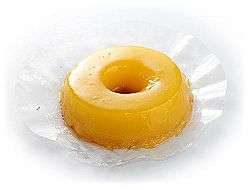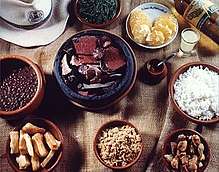Quindim
Quindim (![]()
 | |
| Type | Custard |
|---|---|
| Course | Dessert |
| Place of origin | Brazil |
| Serving temperature | Cold |
| Main ingredients | Ground coconut, sugar, egg yolks |
 |
| Part of a series on |
| Brazilian cuisine |
|---|
| Types of food |
| See also |
|
Etymology
The word quindim comes from dikende in Kikongo, a Bantu language. It means "the gestures, or demeanor, or humor characteristic of adolescent girls."[3]
Origins
The heavy use of egg yolks is characteristic of many Portuguese sweets and pastries, such as the papo de anjo ("angel's double chin") and fios de ovos ("egg threads"). Their combination with coconut and sugar was probably created by African slaves in 17th century Brazilian Northeast, where coconuts were abundant and sugar (from sugarcane) was a major industry.
In popular culture
Quindim is also a rhinoceros character (named after the dessert) featured in Monteiro Lobato's children's books.[4]
See also
References
- Lopes, Nei (1996). Novo dicionário banto do Brasil: contendo mais de 250 propostas etmológicas acolhidas pelo dicionário Houaiss (in Portuguese). Rio de Janeiro: Pallas. p. 217.
- Fundamentos de panificação e confeitaria (in Portuguese). São Paulo: SENAI-SP Editora. 2016. p. 54. ISBN 9788583933298.
- John T. Schneider (1991). Dictionary of African Borrowings in Brazilian Portuguese. Buske Verlag. p. 254.
- Lobato, Monteiro. Quindim - Um Doce de Rinoceronte (in Portuguese). Rio de Janeiro: Globo. ISBN 9788525037602.
External links
- Quindim – DessertEater.com
- Quindim Recipe
- Quindim
- RECIPE - Quindim (from FENADOCE)
- Coconut quindim